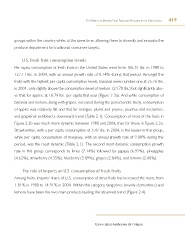Page 419 - FRUTAS DEL TRÓPICO
P. 419
419
the maRket foR impoRted fResh fRuits and vegetables in the united states
groups within the country while, at the same time, allowing them to diversify and innovate the
produce department for traditional consumer targets.
U.S. fresh fruit consumption trends
Per capita consumption of fresh fruits in the United States went from 106.51 lbs. in 1980 to
127.11 lbs. in 2004, with an annual growth rate of 0.74% during that period. Amongst the
fruits with the highest per capita consumption levels, bananas were number one at 25.76 lbs.
in 2004, only slightly above the consumption level of melons (24.70 lbs.) but significantly abo-
ve that for apples, at 18.79 lbs. per capita that year (Figure 2.3a). And while consumption of
bananas and melons, along with grapes, increased during the period under study, consumption
of apples was relatively flat and that for oranges, plums and prunes, peaches and nectarines,
and grapefruit exhibited a downward trend (Table 2.1). Consumption of most of the fruits in
Figure 2.3b was much more dynamic between 1980 and 2004, than for those in Figure 2.3a.
Strawberries, with a per capita consumption of 5.47 lbs. in 2004, is the leader in this group,
while per capita consumption of mangoes, with an annual growth rate of 9.08% during this
period, was the most dynamic (Table 2.1). The second most dynamic consumption growth
rate in this group corresponds to limes (7.14%) followed by papaya (6.92%), pineapples
(4.62%), strawberry (4.35%), blueberry (3.89%), grapes (2.84%), and lemons (2.08%).
The role of imports on U.S. consumption of fresh fruits
Among fruits, imports’ share of U.S. consumption of citrus fruits has increased the most, from
1.81% in 1980 to 14.91% in 2004. Within this category, tangerines (mainly clementines) and
lemons have been the two main products leading the observed trend (Figure 2.4).
Universidad Autónoma de Chiapas

